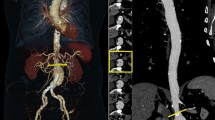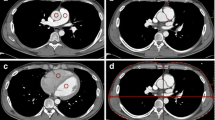Abstract
To evaluate whether the patient-specific contrast enhancement optimizer simulation software (p-COP) is useful for predicting contrast enhancement during whole-body computed tomography angiography (WBCTA). We randomly divided the patients into two groups using a random number table. We used the contrast material (CM) injection protocol selected by p-COP in group A (n = 52). The p-COP used an algorithm including data on the individual patient’s cardiac output. Group B (n = 50) was assigned to the conventional CM injection protocol based on body weight. We compared the CT number in the abdominal aorta at the celiac artery level between the two groups and classified them as acceptable (> 280 HU) and unacceptable (< 279 HU) based on the optimal CT number for the WBCTA scans. To evaluate the difference in both injection protocols, we compared the visual inspection of the images of the artery of Adamkiewicz in both protocols. The CM dosage and injection rate in group A were significantly lower than those in group B (480.8 vs. 501.1 mg I/kg and 3.1 vs. 3.3 ml/s, p < 0.05). The CT number of the abdominal aorta at the celiac level was 382.4 ± 62.3 HU in group A and 363.8 ± 71.3 HU in group B (p = 0.23). CM dosage and injection rate were positively correlated to cardiac output for group A (r = 0.80, p < 0.05) and group B (r = 0.16, p < 0.05). The number of patients with an acceptable CT number was higher in group A [46/6 (86.7%)] than in group B [43/7 (71.4%)], but not significant (p = 0.71). The visualization rate for the Adamkiewicz artery was not significantly different between groups A and B (p = 0.89). The p-COP was useful for predicting contrast enhancement during WBCTA with a lower CM dosage and a lower contrast injection rate than that based on the body weight protocol. In patients with lower cardiac output a reduction in contrast injection rate and CM dosage did not lead to a reduced imaging quality, thus particularly in this group CM dosage can be reduced by p-COP.


Similar content being viewed by others
References
Dake MD, Miller DC, Semba CP, Mitchell RS, Walker PJ, Liddell RP (1994) Transluminal placement of endovascular stent-grafts for the treatment of descending thoracic aortic aneurysms. N Engl J Med 331(26):1729–1734
Volodos NL, Shekhanin VE, Karpovich IP, Troian VI, Gur’ev IuA (1986) A self-fixing synthetic blood vessel endoprosthesis. Vestn Khir Im I I Grek 137(11):123–125
Wanhainen A, Verzini F, Van Herzeele I, Allaire E, Bown M, Cohnert T, Dick F, van Herwaarden J, Karkos C, Koelemay M, Kölbel T, Loftus I, Mani K, Melissano G, Powell J, Szeberin Z, Esvs Guidelines C, de Borst GJ, Chakfe N, Debus S, Hinchliffe R, Kakkos S, Koncar I, Kolh P, Lindholt JS, de Vega M, Vermassen F, Document R, Björck M, Cheng S, Dalman R, Davidovic L, Donas K, Earnshaw J, Eckstein HH, Golledge J, Haulon S, Mastracci T, Naylor R, Ricco JB, Verhagen H (2019) Editor’s choice—European Society for Vascular Surgery (ESVS) 2019 clinical practice guidelines on the management of abdominal aorto-iliac artery aneurysms. Eur J Vasc Endovasc Surg 57(1):8–93
Moll FL, Powell JT, Fraedrich G, Verzini F, Haulon S, Waltham M, van Herwaarden JA, Holt PJ, van Keulen JW, Rantner B, Schlösser FJ, Setacci F, Ricco JB (2011) Management of abdominal aortic aneurysms clinical practice guidelines of the European society for vascular surgery. Eur J Vasc Endovasc Surg 41(Suppl 1):S1-s58
Valente T, Rossi G, Rea G, Pinto A, Romano L, Davies J, Scaglione M (2014) Multidetector CT findings of complications of surgical and endovascular treatment of aortic aneurysms. Radiol Clin North Am 52(5):961–989
Heiken JP, Brink JA, McClennan BL, Sagel SS, Crowe TM, Gaines MV (1995) Dynamic incremental CT: effect of volume and concentration of contrast material and patient weight on hepatic enhancement. Radiology 195(2):353–357
Yanaga Y, Awai K, Nakayama Y, Nakaura T, Tamura Y, Funama Y, Aoyama M, Asada N, Yamashita Y (2007) Optimal dose and injection duration (injection rate) of contrast material for depiction of hypervascular hepatocellular carcinomas by multidetector CT. Radiat Med 25(6):278–288
Awai K, Hori S (2003) Effect of contrast injection protocol with dose tailored to patient weight and fixed injection duration on aortic and hepatic enhancement at multidetector-row helical CT. Eur Radiol 13(9):2155–2160
Yamashita Y, Komohara Y, Takahashi M, Uchida M, Hayabuchi N, Shimizu T, Narabayashi I (2000) Abdominal helical CT: evaluation of optimal doses of intravenous contrast material—a prospective randomized study. Radiology 216(3):718–723
Higaki T, Nakaura T, Kidoh M, Yuki H, Yamashita Y, Nakamura Y, Tatsugami F, Baba Y, Iida M, Awai K (2018) Effect of contrast material injection duration on arterial enhancement at CT in patients with various cardiac indices: analysis using computer simulation. PLoS One 13(2):e0191347
Matsumoto Y, Higaki T, Arataki K, Masuda T, Sato T, Fukumoto W, Nakamura Y, Tatsugami F, Awai K (2020) Individual optimization of contrast media injection protocol at hepatic dynamic computed tomography using patient-specific contrast enhancement optimizer. J Comput Assist Tomogr 44(2):230–235
Matsumoto Y, Higaki T, Masuda T, Sato T, Nakamura Y, Tatsugami F, Awai K (2019) Minimizing individual variations in arterial enhancement on coronary CT angiographs using “contrast enhancement optimizer”: a prospective randomized single-center study. Eur Radiol 29(6):2998–3005
Bae KT, Heiken JP, Brink JA (1998) Aortic and hepatic contrast medium enhancement at CT. Part I. Prediction with a computer model. Radiology 207(3):647–655
Bae KT, Heiken JP, Brink JA (1998) Aortic and hepatic contrast medium enhancement at CT. Part II. Effect of reduced cardiac output in a porcine model. Radiology 207(3):657–662
Bae KT, Heiken JP, Brink JA (1998) Aortic and hepatic peak enhancement at CT: effect of contrast medium injection rate–pharmacokinetic analysis and experimental porcine model. Radiology 206(2):455–464
Blohm ME, Obrecht D, Hartwich J, Mueller GC, Kersten JF, Weil J, Singer D (2014) Impedance cardiography (electrical velocimetry) and transthoracic echocardiography for non-invasive cardiac output monitoring in pediatric intensive care patients: a prospective single-center observational study. Crit Care 18(6):603
Hsu KH, Wu TW, Wang YC, Lim WH, Lee CC, Lien R (2016) Hemodynamic reference for neonates of different age and weight: a pilot study with electrical cardiometry. J Perinatol 36(6):481–485
Halpern EJ (2009) Triple-rule-out CT angiography for evaluation of acute chest pain and possible acute coronary syndrome. Radiology 252(2):332–345
Higashigaito K, Schmid T, Puippe G, Morsbach F, Lachat M, Seifert B, Pfammatter T, Alkadhi H, Husarik DB (2016) CT angiography of the aorta: prospective evaluation of individualized low-volume contrast media protocols. Radiology 280(3):960–968
Lehmkuhl L, Andres C, Lücke C, Hoffmann J, Foldyna B, Grothoff M, Nitzsche S, Schmidt A, Ulrich M, Scheinert D, Gutberlet M (2013) Dynamic CT angiography after abdominal aortic endovascular aneurysm repair: influence of enhancement patterns and optimal bolus timing on endoleak detection. Radiology 268(3):890–899
Sommer WH, Becker CR, Haack M, Rubin GD, Weidenhagen R, Schwarz F, Nikolaou K, Reiser MF, Johnson TR, Clevert DA (2012) Time-resolved CT angiography for the detection and classification of endoleaks. Radiology 263(3):917–926
Tillich M, Hausegger KA, Tiesenhausen K, Tauss J, Groell R, Szolar DH (1999) Helical CT angiography of stent-grafts in abdominal aortic aneurysms: morphologic changes and complications. Radiographics 19(6):1573–1583
Yoshioka K, Niinuma H, Ehara S, Nakajima T, Nakamura M, Kawazoe K (2006) MR angiography and CT angiography of the artery of Adamkiewicz: state of the art. Radiographics 26(Suppl 1):S63-73
Meng X-L, Rosenthal R, Rubin DB (1992) Comparing correlated correlation coefficients. Psychol Bull 111(1):172–175
Nakaura T, Awai K, Yauaga Y, Nakayama Y, Oda S, Hatemura M, Nagayoshi Y, Ogawa H, Yamashita Y (2008) Contrast injection protocols for coronary computed tomography angiography using a 64-detector scanner: comparison between patient weight-adjusted- and fixed iodine-dose protocols. Invest Radiol 43(7):512–519
Masuda T, Nakaura T, Funama Y, Higaki T, Kiguchi M, Imada N, Sato T, Awai K (2017) Aortic and hepatic contrast enhancement during hepatic-arterial and portal venous phase computed tomography scanning: multivariate linear regression analysis using age, sex, total body weight, height, and cardiac output. J Comput Assist Tomogr 41(2):309–314
Bae KT, Heiken JP (2005) Scan and contrast administration principles of MDCT. Eur Radiol 15(Suppl 5):E46-59
Fleischmann D (2005) How to design injection protocols for multiple detector-row CT angiography (MDCTA). Eur Radiol 15(Suppl 5):E60-65
Sakai S, Yabuuchi H, Chishaki A, Okafuji T, Matsuo Y, Kamitani T, Setoguchi T, Honda H (2010) Effect of cardiac function on aortic peak time and peak enhancement during coronary CT angiography. Eur J Radiol 75(2):173–177
Ameli-Renani S, Pavlidis V, Morgan RA (2020) Secondary endoleak management following TEVAR and EVAR. Cardiovasc Intervent Radiol 43(12):1839–1854
Bley T, Roos J (2019) IDKD springer series pre- and post-aortic endovascular interventions: what a radiologist needs to know. In: Hodler J, Kubik-Huch RA, von Schulthess GK (eds) Diseases of the chest, breast, heart and vessels 2019–2022: diagnostic and interventional imaging. Springer, Cham, pp 215–222
Taterra D, Skinningsrud B, Pękala PA, Hsieh WC, Cirocchi R, Walocha JA, Tubbs RS, Tomaszewski KA, Henry BM (2019) Artery of Adamkiewicz: a meta-analysis of anatomical characteristics. Neuroradiology 61(8):869–880
Author information
Authors and Affiliations
Corresponding author
Ethics declarations
Conflict of interest
The authors have no conflicts of interest directly relevant to the content of this article.
Additional information
Publisher's Note
Springer Nature remains neutral with regard to jurisdictional claims in published maps and institutional affiliations.
Rights and permissions
About this article
Cite this article
Masuda, T., Higaki, T., Nakaura, T. et al. Usefulness of the patient-specific contrast enhancement optimizer simulation software during the whole-body computed tomography angiography. Heart Vessels 37, 1446–1452 (2022). https://doi.org/10.1007/s00380-022-02024-z
Received:
Accepted:
Published:
Issue Date:
DOI: https://doi.org/10.1007/s00380-022-02024-z




